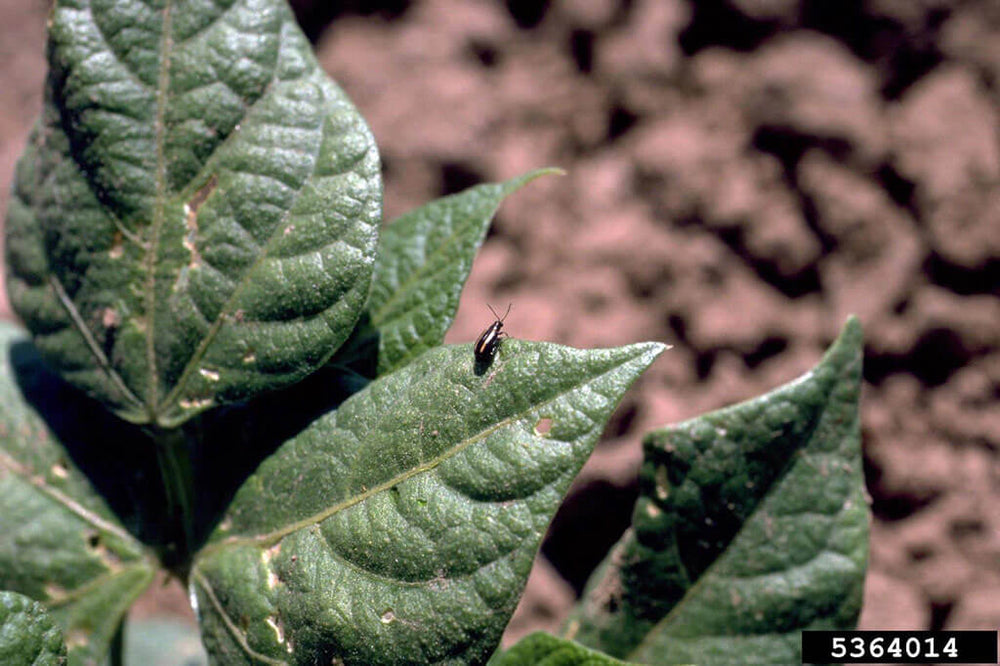
What's that jumping all over your vegetable plants? It could be flea beetles, a tiny leaf-eating pest that attacks gardens with full force come spring. They're not actually fleas; they get their moniker from how they leap into the air when disturbed. And while they're never fun to discover, there's no need to fret. There are plenty of smart strategies you can implement to prevent and get rid of flea beetles.
How to get rid of flea beetles.
What are flea beetles?
Flea beetles are tiny, shiny, mostly black beetles that jump like fleas when disturbed (hence the name). The easiest way to identify this pest is by their tiny size (they're about 1/10 of an inch long—slightly larger than a pinhead) and their jumping movement. They appear in the spring after spending the winter in the ground, in tall grass, or in garden refuse.
Flea beetles feed on a variety of vegetables. The adults prefer tender, new, leafy growth and frequently attack seedlings. As the beetles feed, they riddle leaves with small holes. Adult flea beetle damage has the greatest potential to ruin the harvest or kill plants.
The young larvae, on the other hand, feed on plant roots and rarely cause significant damage.
How do I prevent flea beetles?
Flea beetle prevention starts the year before and continues into the following spring with physical barriers and smart timing.
- Keep your garden clean. Adult beetles overwinter in plant debris. To help prevent new infestations each year, clean up crops as soon as they're harvested. Keep the garden clean of all plant parts, including dead leaves and fallen fruits. This is especially important as fall winds down and insects begin searching for winter shelter.
- Use row covers. A floating row cover is a lightweight piece of white spun fabric that lies over plants like a blanket. It lets sunlight, air, and water through, but prevents beetles from landing on leaves. Make sure edges are anchored well to prevent beetles from sneaking in. Don't forget to remove the cover when plants are flowering so pollination can occur. Learn more about row covers.
- Plant late. Flea beetles emerge in spring and seek out young seedlings. Many times they'll stop attacking when plants have 4 to 5 new leaves. Delay planting as long as possible so that warmer air temperatures can fuel rapid seedling growth.
- Grow nasturtium, calendula, and French marigolds, which help repel flea beetles.
How do I control flea beetles if I have them?
Flea beetles multiply fast. In many regions, you'll see multiple generations of flea beetles during a single growing season. If you see them in your garden, it's important to act quickly.
- Clean as you grow. It's important to clean up the garden—don't leave dead plants or plant debris behind, as they can harbor new generations of flea beetles. The fewer hiding places, the better.
- Spray. You can spray adults with an insecticide product that kills flea beetles, such as Ortho® Insect, Mite & Disease 3-in-1, as soon as you see them. Apply as directed on the product label and avoid spraying when bees are active.
Need more info and local pesticide recommendations? Contact your regional Extension agent. You can find the nearest Extension office through the Cooperative Extension System map.
The good news is, flea beetles typically become less of an issue as spring moves into summer. But until then, you have a variety of easy prevention and control strategies to help keep your garden free from these leaf-loving pests.





 Herbs
Herbs
 Vegetables
Vegetables
 Fruit
Fruit
 Flowers
Flowers
 Succulents
Succulents


